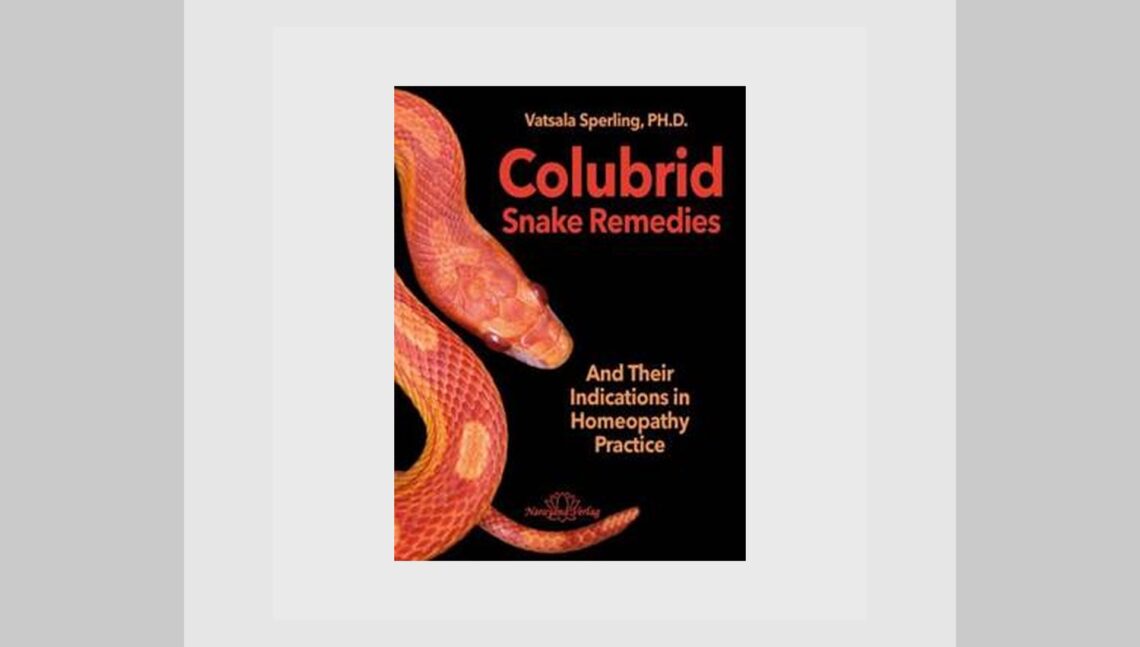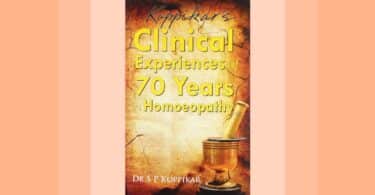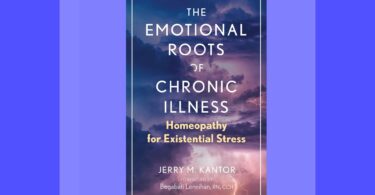Author: Vatsala Sperling
Publisher: Narayana Verlag, Germany
ISBN: 978-3-96257-322-5
Other details: Year of publishing: 2023, pages 232, flexible cover, full color
Order from: Narayana Verlag
Reviewer: Dr. Richard Grossinger, Ph. D.

While the world at large spends much time and energy either justifying or negating homeopathy, Vatsala Sperling spends no time at all in these pursuits in her book Colubrid Snake Remedies and Their Indications in Homeopathy Practice and goes straight to the heart of the remedies from snakes.
Such directness and focus make this book not only an encyclopedic reference on using potentized biological material from diverse snakes and snake allies as medicines but a bold step in a new homeopathy that validates and justifies itself not by arguments about the power of microdoses and similars but by committed adherence to the system itself.
Sperling recognizes that we are on the verge of a new era of meaning and understanding in which multiple interlocking explanations fluctuate under the surface of, in truth not only homeopathy, but allopathy, physics, biology, and symbolic psychology. Furthermore, in a bureaucratically administered reality, the homeopath must avoid wasting energy fighting an establishment biased against its premises. She writes:
“[V]ery non-clinical, non-interrogative, non-probing, free flowing, calming, and at the same time very focused listening is even more important now than it was in Hahnemann’s time. He paid attention to diseases and as a medical doctor prescribed for and treated disease conditions.
In the current socio-political climate, even medically trained homeopaths cannot claim to be treating anything. So, what do we do? We do what Hahnemann asked us to do, we ‘Listen.’ But we listen for and hear a life narrative besides listening for the symptoms.”
As far as snakes go (mostly non-aggressive, non-poisonous, but with plenty of venomous vipers and some alligators and fossilized dinosaur remains thrown in), Sperling captures the striking relationship between the behavioral and physiological traits of snakes in nature and natural history as well as human propensities, attributes, and demeanors.
With this scope and breadth, she derives, scientifically as well as intuitively, vital-energy forms that the Colubrid and allied reptile kingdoms contain. Then she applies them to client constitutions and ailments. In this explication, she follows a few perspicacious homeopaths who analyzed individualized patterns and quintessences all way back to the Periodic Chart of Elements based on the arrangement of particles in atomic nuclei, the entire plant kingdom, animal kingdom as well as imponderables.
No conclusion, either reductive or quantum, can be drawn about these hierarchies, except that we exist in a patterned continuity and should take advantage of it in bringing about health and an activating torpid system. Snakes are highly patterned, active, determined life forms, so provide a sound basis—living epitomes—for repertorization.
Plants and minerals often take the spotlight, giving an indication to the layperson that homeopathy is nothing but herbal and supplemental intervention. Even though plant and mineral remedies come up prominently when patient’s symptoms are repertorized, homeopathy includes a vast treasure-trove of remedies from the animal kingdom as well.
After all, a potentized molecule is not animal, vegetable, or mineral, but energy, space, and vibration. In fact, as homeopaths know, anything can be potentized because everything contains the energy of manifestation. Her message: do not forget snakes when potentizing the rest of the garden.
On snakes, Sperling is thorough and eclectic, honoring the maxim that “All that slithers is not Lachesis.” She makes a proposition that all cases calling out for remedies from snakes may not necessarily need a remedy from venomous snakes like Lachesis.
Many of these cases could require remedies from less threatening nonvenomous Colubrid snakes. Sperling uses six cases from her practice as an example and expands upon the themes, likely human expressions, body gestures as well as unspoken expression of innate energy that point her to choosing remedies from five different nonvenomous Colubrid snakes, Natrix natrix, Thamnophis sirtalis, Cyclagras gigas, Elaphe guttata, Lampropeltis triangulum.
To enable her readers to clearly distinguish the differences between venomous and nonvenomous Colubrid snakes, Sperling devotes a sizeable portion of her book to laying out the general, maternal, predatory, anti-predatory behaviors and likely human expressions from people requiring remedies from powerful venomous snakes from Elapidae and Viperidae families, for example, highland moccasins, rattlesnakes, puff adders, sunbeam snakes, tree snakes, pipe snakes, and cobras and so on.
Many of these venomous snakes come up on the repertorization chart when symptoms are chosen for repertorization. However, Sperling elucidates the point with case examples that focus on the life narrative and how it is expressed during casetaking, so we can spot the main feature of non-venomous Colubrid snakes – mimicry of venomous snakes with the sole purpose of survival.
Nonvenomous Colubrid snakes mimic the dangerous, venomous snakes, and they appear as something that they are not. Similarly, patients requiring remedies from Colubrid snakes are presenting a threatening picture, but they are in fact simply mimicking a threatening posture for the sake of survival.
Sperling’s snakes are not just reduced to their medicinal potential. To repertorize her “snake remedies,” she discusses their anatomy, habitats, predation, flight, self-defense, and maternal capacity and habits.
Among the human expressions of snakes that she explores and organizes in her Colubrid materia medica are desire for safety, revenge, dependence soon after birth, patience, love for bright colors, female dominance, fear of falling off heights, self-promotion, intense but fake anger, substance abuse, fear of abandonment, paranoia, suspicion, parental abuse, feeling at a disadvantage, becoming still when encountering a predator they cannot avoid, appears sexier than she is, wants to save her skin and not get trampled. and so on.
This book is illustrated in full Colubrid color, allowing direct impressions of specific snakes. Sperling concludes the book with summaries, and charts for a deep but quick experience of snakes, people, elements, and homeopathy together.
Compendiums like this show the unexplored potential of nanodoses and potentization, for nature is full of creatures and substances unknown as well as known, and Sperling proposes that the various species that co-exist under one sky have in fact a purpose – and the collective purpose is to help heal each other.
For me, Sperling’s work provides a usually unexamined link between sixteenth-century sigils and twentieth-century structuralism, a link that encompasses the phenomenologists and structuralists and their forerunner Sigmund Freud.
She refers to none of this, but it is implicit in her inevasible modernism, as she cannot help but see homeopathy beyond the most common limiting rubrics and disease pictures. Synchronously, at the very moment at which I undertook this review of Colubrid Snake Remedies, I ran across a translation a friend did in the 1960s of a section of Michel Foucault’s Words and Things (later professionally translated as The Order of Things) in the context of my discovery of homeopathy and the Doctrine of Similars. It speaks to my own homeopathic roots, signatures, sigils, similars, and snakes in a single timeless archetype:
When one has the story of an animal to tell, it is useless and impossible to choose between the role of a naturalist and that of an anthologist: in one and the same form of knowledge must be gathered all that has been seen and heard, all that has been related by nature or by men in the language of the world, of tradition, or of poets.
To know a beast, or a plant, or anything from the earth is to collect the whole thick layer of signs that have been deposited in them or on them; it is to recover all the constellations of forms when they take on the characteristic of emblems. . .”
“Equivocation (the different senses in which the word serpent can be used), synonyms and etymologies, differences, form and description, anatomy, character and habitats, temperament, sex and reproduction, voice, movements, places, food, physiognomy, antipathy, sympathy, ways to catch, death and wounds by the serpent, methods and signs of poisoning, remedies, epithets, designations, marvels and omens, monsters, mythology, gods to which he is consecrated, fables, allegories and mysteries, hieroglyphics, emblems and symbols, adages, coins, miracles, enigmas, devices, heraldic signs, deeds, dreams, reproductions and statues, uses as food, uses in medicine, diverse uses. . . .
“[N]ature, itself, is a seamless fabric of words and marks, of stories and letters, of discourses and forms.… There can be no commentary unless beneath the text that one reads and explicates, runs the sovereignty of an original Text.”
Sperling has plumbed that original text for snakes while contributing to the world’s sovereign pharmacopoeia.







